2007 SUZUKI FORENZA service
[x] Cancel search: servicePage 136 of 225

4-12 DRIVING YOUR VEHICLE
85Z03-03E
Tires: They are vitally important to a
safe, trouble-free trip. Is the tread good
enough for long-distance driving? Are
the tires all inflated to the recommended
pressure?
Weather Forecasts: What’s the weather
outlook along your route? Should you
delay your trip a short time to avoid a
major storm system?
Maps: Do you have up-to-date maps?Highway HypnosisIs there actually such a condition as “high-
way hypnosis”? Or is it just plain falling
asleep at the wheel? Call it highway hyp-
nosis, lack of awareness, or whatever.
There is something about an easy stretch
of road with the same scenery, along with
the hum of the tires on the road, the drone
of the engine, and the rush of the wind
against the vehicle that can make you
sleepy. Don’t let it happen to you! If it does,
your vehicle can leave the road in less than
a second, and you could crash and be
injured.
What can you do about highway hypnosis?
First, be aware that it can happen.
Then here are some tips:
Make sure your vehicle is well ventilated,
with a comfortably cool interior.
Keep your eyes moving. Scan the road
ahead and to the sides. Check your rear-
view mirrors and your instruments fre-
quently. If you get sleepy, pull off the road into a
rest, service or parking area and take a
nap, get some exercise, or both. For
safety, treat drowsiness on the highway
as an emergency.
Hill and Mountain RoadsDriving on steep hills or mountains is differ-
ent from driving in flat or rolling terrain.
If you drive regularly in steep country, or if
you’re planning to visit there, here are
some tips that can make your trips safer
and more enjoyable.
Keep your vehicle in good shape. Check
all fluid levels and also the brakes, tires,
cooling system and transmission. These
parts can work hard on mountain roads.
Know how to go down hills. The most
important thing to know is this: let your
engine do some of the slowing down.Shift to a lower gear when you go down
a steep or long hill.
Know how to go uphill. You may want to
shift down to a lower gear. The lower
gears help cool your engine and trans-
mission, and you can climb the hill bet-
ter.
Stay in your own lane when driving on
two-lane roads in hills or mountains.
Don’t swing wide or cut across the cen-
ter of the road. Drive at speeds that let
you stay in your own lane.
WARNING
If you don’t shift down, your brakes
could get so hot that they wouldn’t
work well. You would then have poor
braking or even none going down a
hill. You could crash. Shift down to let
your engine assist your brakes on a
steep downhill slope.
WARNING
Coasting downhill in NEUTRAL (N) or
with the ignition off is dangerous.
Your brakes will have to do all the
work of slowing you down. They
could get so hot that they wouldn’t
work well. You would then have poor
braking or even none going down a
hill. You could crash. Always have
your engine running and your vehicle
in gear when you go downhill.
Your Driving, the Road, and Your Vehicle:
Page 140 of 225
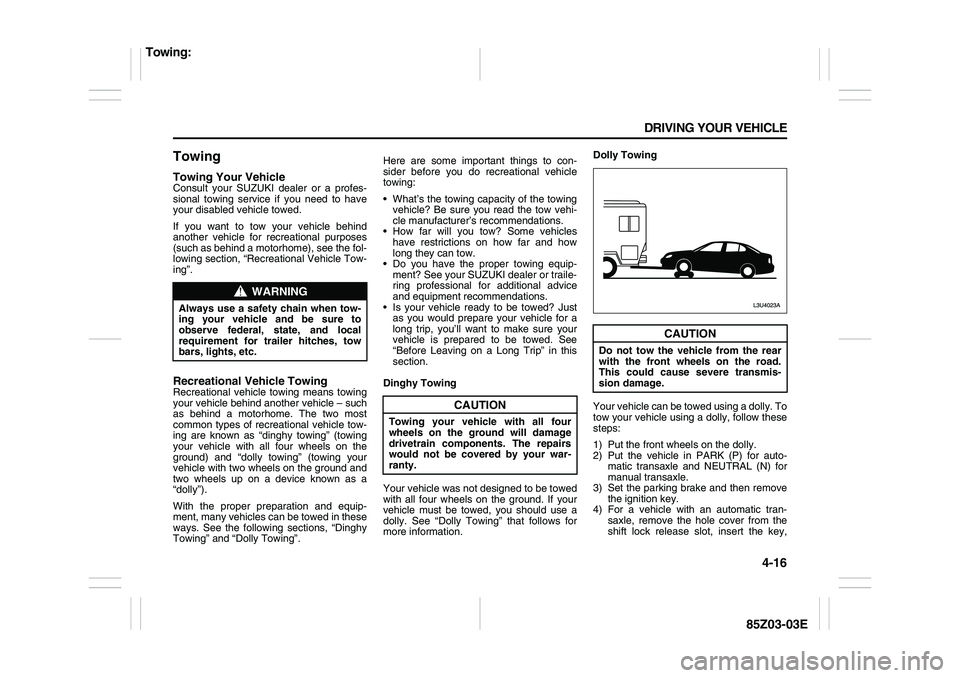
4-16 DRIVING YOUR VEHICLE
85Z03-03E
TowingTowing Your VehicleConsult your SUZUKI dealer or a profes-
sional towing service if you need to have
your disabled vehicle towed.
If you want to tow your vehicle behind
another vehicle for recreational purposes
(such as behind a motorhome), see the fol-
lowing section, “Recreational Vehicle Tow-
ing”.Recreational Vehicle TowingRecreational vehicle towing means towing
your vehicle behind another vehicle – such
as behind a motorhome. The two most
common types of recreational vehicle tow-
ing are known as “dinghy towing” (towing
your vehicle with all four wheels on the
ground) and “dolly towing” (towing your
vehicle with two wheels on the ground and
two wheels up on a device known as a
“dolly”).
With the proper preparation and equip-
ment, many vehicles can be towed in these
ways. See the following sections, “Dinghy
Towing” and “Dolly Towing”.Here are some important things to con-
sider before you do recreational vehicle
towing:
What’s the towing capacity of the towing
vehicle? Be sure you read the tow vehi-
cle manufacturer’s recommendations.
How far will you tow? Some vehicles
have restrictions on how far and how
long they can tow.
Do you have the proper towing equip-
ment? See your SUZUKI dealer or traile-
ring professional for additional advice
and equipment recommendations.
Is your vehicle ready to be towed? Just
as you would prepare your vehicle for a
long trip, you’ll want to make sure your
vehicle is prepared to be towed. See
“Before Leaving on a Long Trip” in this
section.
Dinghy Towing
Your vehicle was not designed to be towed
with all four wheels on the ground. If your
vehicle must be towed, you should use a
dolly. See “Dolly Towing” that follows for
more information.Dolly Towing
Your vehicle can be towed using a dolly. To
tow your vehicle using a dolly, follow these
steps:
1) Put the front wheels on the dolly.
2) Put the vehicle in PARK (P) for auto-
matic transaxle and NEUTRAL (N) for
manual transaxle.
3) Set the parking brake and then remove
the ignition key.
4) For a vehicle with an automatic tran-
saxle, remove the hole cover from the
shift lock release slot, insert the key,
WARNING
Always use a safety chain when tow-
ing your vehicle and be sure to
observe federal, state, and local
requirement for trailer hitches, tow
bars, lights, etc.
CAUTION
Towing your vehicle with all four
wheels on the ground will damage
drivetrain components. The repairs
would not be covered by your war-
ranty.
CAUTION
Do not tow the vehicle from the rear
with the front wheels on the road.
This could cause severe transmis-
sion damage.
Towing:
Page 144 of 225

SERVICE AND APPEARANCE CARE
5
85Z03-03E
SERVICE AND APPEARANCE CAREService ................................................................................. 5-1
Fuel ....................................................................................... 5-1
Checking Things Under the Hood ..................................... 5-4
Headlamp Aiming ................................................................ 5-23
Bulb Replacement ............................................................... 5-23
Windshield Wiper Blade Replacement .............................. 5-28
Tires ...................................................................................... 5-28
Tire Pressure Monitoring System ...................................... 5-33
Appearance Care ................................................................. 5-45
Vehicle Identification .......................................................... 5-49
Electrical System ................................................................ 5-49
Capacities and Specifications ........................................... 5-54
Page 145 of 225
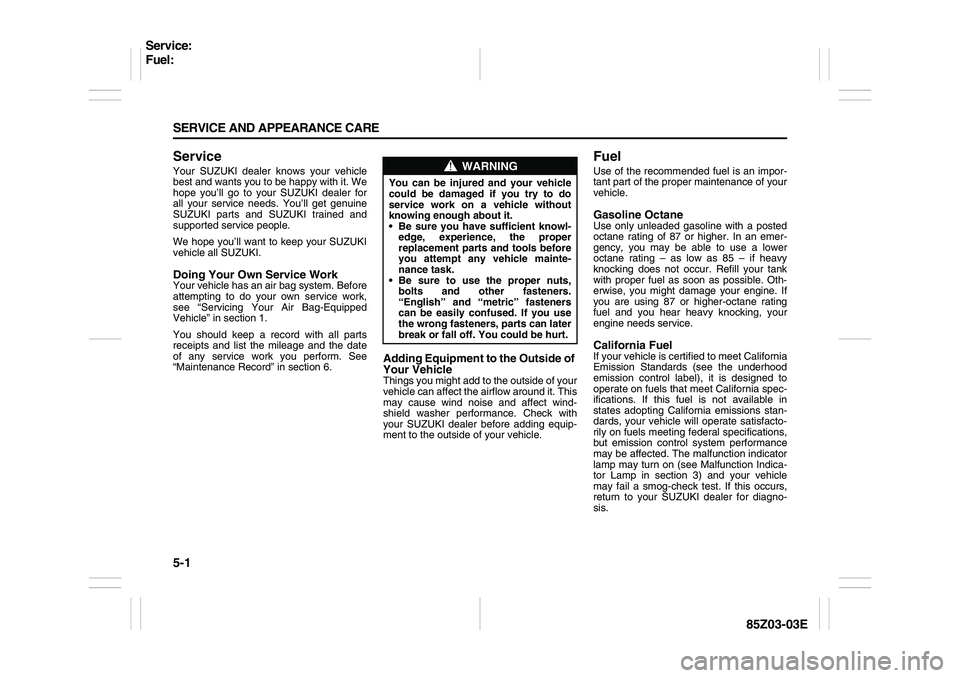
5-1 SERVICE AND APPEARANCE CARE
85Z03-03E
ServiceYour SUZUKI dealer knows your vehicle
best and wants you to be happy with it. We
hope you’ll go to your SUZUKI dealer for
all your service needs. You’ll get genuine
SUZUKI parts and SUZUKI trained and
supported service people.
We hope you’ll want to keep your SUZUKI
vehicle all SUZUKI. Doing Your Own Service WorkYour vehicle has an air bag system. Before
attempting to do your own service work,
see “Servicing Your Air Bag-Equipped
Vehicle” in section 1.
You should keep a record with all parts
receipts and list the mileage and the date
of any service work you perform. See
“Maintenance Record” in section 6.
Adding Equipment to the Outside of
Your VehicleThings you might add to the outside of your
vehicle can affect the airflow around it. This
may cause wind noise and affect wind-
shield washer performance. Check with
your SUZUKI dealer before adding equip-
ment to the outside of your vehicle.
FuelUse of the recommended fuel is an impor-
tant part of the proper maintenance of your
vehicle.Gasoline OctaneUse only unleaded gasoline with a posted
octane rating of 87 or higher. In an emer-
gency, you may be able to use a lower
octane rating – as low as 85 – if heavy
knocking does not occur. Refill your tank
with proper fuel as soon as possible. Oth-
erwise, you might damage your engine. If
you are using 87 or higher-octane rating
fuel and you hear heavy knocking, your
engine needs service.California FuelIf your vehicle is certified to meet California
Emission Standards (see the underhood
emission control label), it is designed to
operate on fuels that meet California spec-
ifications. If this fuel is not available in
states adopting California emissions stan-
dards, your vehicle will operate satisfacto-
rily on fuels meeting federal specifications,
but emission control system performance
may be affected. The malfunction indicator
lamp may turn on (see Malfunction Indica-
tor Lamp in section 3) and your vehicle
may fail a smog-check test. If this occurs,
return to your SUZUKI dealer for diagno-
sis.
WARNING
You can be injured and your vehicle
could be damaged if you try to do
service work on a vehicle without
knowing enough about it.
Be sure you have sufficient knowl-
edge, experience, the proper
replacement parts and tools before
you attempt any vehicle mainte-
nance task.
Be sure to use the proper nuts,
bolts and other fasteners.
“English” and “metric” fasteners
can be easily confused. If you use
the wrong fasteners, parts can later
break or fall off. You could be hurt.
Service:
Fuel:
Page 146 of 225
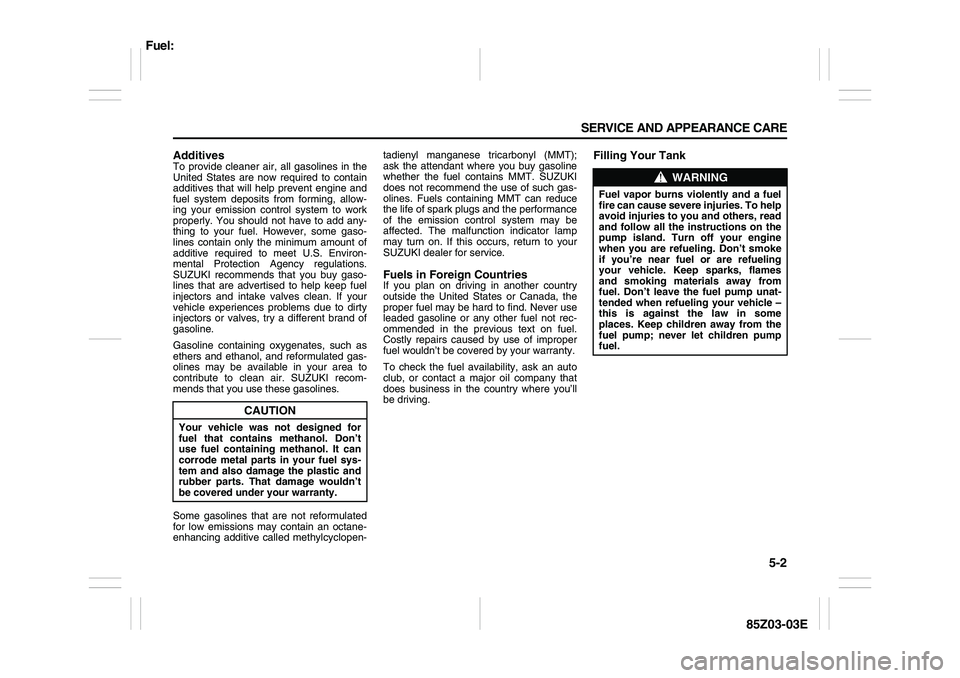
5-2 SERVICE AND APPEARANCE CARE
85Z03-03E
AdditivesTo provide cleaner air, all gasolines in the
United States are now required to contain
additives that will help prevent engine and
fuel system deposits from forming, allow-
ing your emission control system to work
properly. You should not have to add any-
thing to your fuel. However, some gaso-
lines contain only the minimum amount of
additive required to meet U.S. Environ-
mental Protection Agency regulations.
SUZUKI recommends that you buy gaso-
lines that are advertised to help keep fuel
injectors and intake valves clean. If your
vehicle experiences problems due to dirty
injectors or valves, try a different brand of
gasoline.
Gasoline containing oxygenates, such as
ethers and ethanol, and reformulated gas-
olines may be available in your area to
contribute to clean air. SUZUKI recom-
mends that you use these gasolines.
Some gasolines that are not reformulated
for low emissions may contain an octane-
enhancing additive called methylcyclopen-tadienyl manganese tricarbonyl (MMT);
ask the attendant where you buy gasoline
whether the fuel contains MMT. SUZUKI
does not recommend the use of such gas-
olines. Fuels containing MMT can reduce
the life of spark plugs and the performance
of the emission control system may be
affected. The malfunction indicator lamp
may turn on. If this occurs, return to your
SUZUKI dealer for service.
Fuels in Foreign CountriesIf you plan on driving in another country
outside the United States or Canada, the
proper fuel may be hard to find. Never use
leaded gasoline or any other fuel not rec-
ommended in the previous text on fuel.
Costly repairs caused by use of improper
fuel wouldn’t be covered by your warranty.
To check the fuel availability, ask an auto
club, or contact a major oil company that
does business in the country where you’ll
be driving.
Filling Your Tank
CAUTION
Your vehicle was not designed for
fuel that contains methanol. Don’t
use fuel containing methanol. It can
corrode metal parts in your fuel sys-
tem and also damage the plastic and
rubber parts. That damage wouldn’t
be covered under your warranty.
WARNING
Fuel vapor burns violently and a fuel
fire can cause severe injuries. To help
avoid injuries to you and others, read
and follow all the instructions on the
pump island. Turn off your engine
when you are refueling. Don’t smoke
if you’re near fuel or are refueling
your vehicle. Keep sparks, flames
and smoking materials away from
fuel. Don’t leave the fuel pump unat-
tended when refueling your vehicle –
this is against the law in some
places. Keep children away from the
fuel pump; never let children pump
fuel.
Fuel:
Page 147 of 225
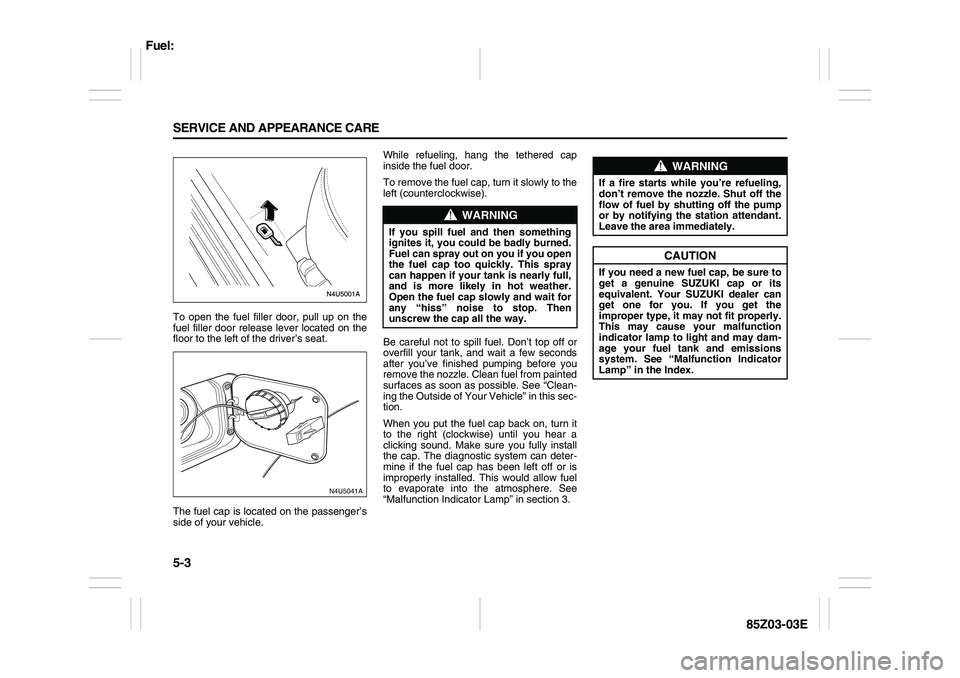
5-3 SERVICE AND APPEARANCE CARE
85Z03-03E
To open the fuel filler door, pull up on the
fuel filler door release lever located on the
floor to the left of the driver’s seat.
The fuel cap is located on the passenger’s
side of your vehicle.While refueling, hang the tethered cap
inside the fuel door.
To remove the fuel cap, turn it slowly to the
left (counterclockwise).
Be careful not to spill fuel. Don’t top off or
overfill your tank, and wait a few seconds
after you’ve finished pumping before you
remove the nozzle. Clean fuel from painted
surfaces as soon as possible. See “Clean-
ing the Outside of Your Vehicle” in this sec-
tion.
When you put the fuel cap back on, turn it
to the right (clockwise) until you hear a
clicking sound. Make sure you fully install
the cap. The diagnostic system can deter-
mine if the fuel cap has been left off or is
improperly installed. This would allow fuel
to evaporate into the atmosphere. See
“Malfunction Indicator Lamp” in section 3.
N4U5041A
WARNING
If you spill fuel and then something
ignites it, you could be badly burned.
Fuel can spray out on you if you open
the fuel cap too quickly. This spray
can happen if your tank is nearly full,
and is more likely in hot weather.
Open the fuel cap slowly and wait for
any “hiss” noise to stop. Then
unscrew the cap all the way.
WARNING
If a fire starts while you’re refueling,
don’t remove the nozzle. Shut off the
flow of fuel by shutting off the pump
or by notifying the station attendant.
Leave the area immediately.
CAUTION
If you need a new fuel cap, be sure to
get a genuine SUZUKI cap or its
equivalent. Your SUZUKI dealer can
get one for you. If you get the
improper type, it may not fit properly.
This may cause your malfunction
indicator lamp to light and may dam-
age your fuel tank and emissions
system. See “Malfunction Indicator
Lamp” in the Index.
Fuel:
Page 148 of 225
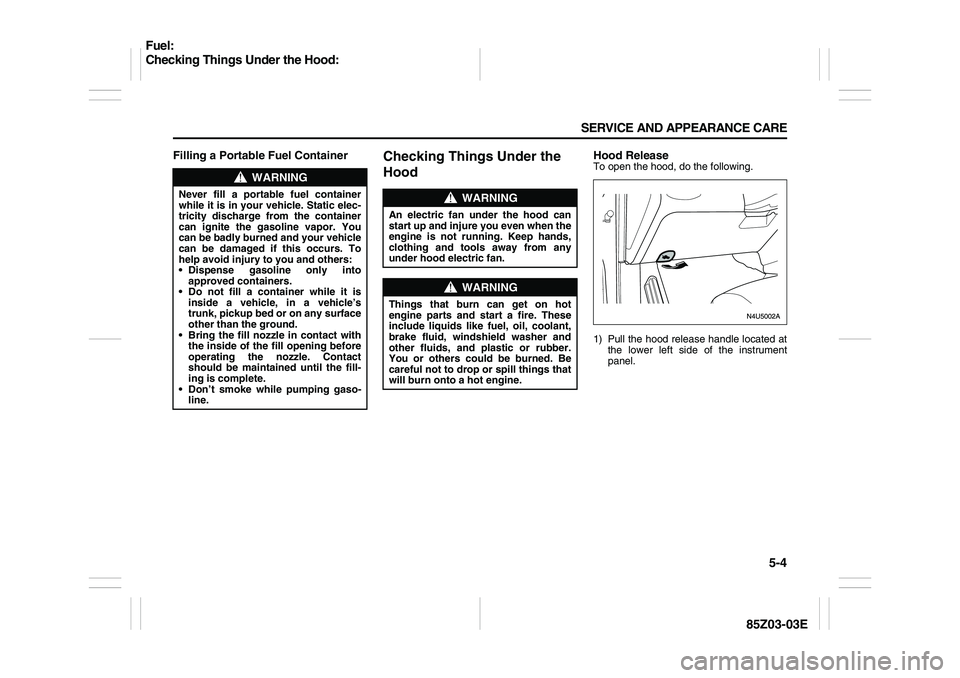
5-4 SERVICE AND APPEARANCE CARE
85Z03-03E
Filling a Portable Fuel Container
Checking Things Under the
Hood
Hood ReleaseTo open the hood, do the following.
1) Pull the hood release handle located at
the lower left side of the instrument
panel.
WARNING
Never fill a portable fuel container
while it is in your vehicle. Static elec-
tricity discharge from the container
can ignite the gasoline vapor. You
can be badly burned and your vehicle
can be damaged if this occurs. To
help avoid injury to you and others:
Dispense gasoline only into
approved containers.
Do not fill a container while it is
inside a vehicle, in a vehicle’s
trunk, pickup bed or on any surface
other than the ground.
Bring the fill nozzle in contact with
the inside of the fill opening before
operating the nozzle. Contact
should be maintained until the fill-
ing is complete.
Don’t smoke while pumping gaso-
line.
WARNING
An electric fan under the hood can
start up and injure you even when the
engine is not running. Keep hands,
clothing and tools away from any
under hood electric fan.
WARNING
Things that burn can get on hot
engine parts and start a fire. These
include liquids like fuel, oil, coolant,
brake fluid, windshield washer and
other fluids, and plastic or rubber.
You or others could be burned. Be
careful not to drop or spill things that
will burn onto a hot engine.
Fuel:
Checking Things Under the Hood:
Page 149 of 225
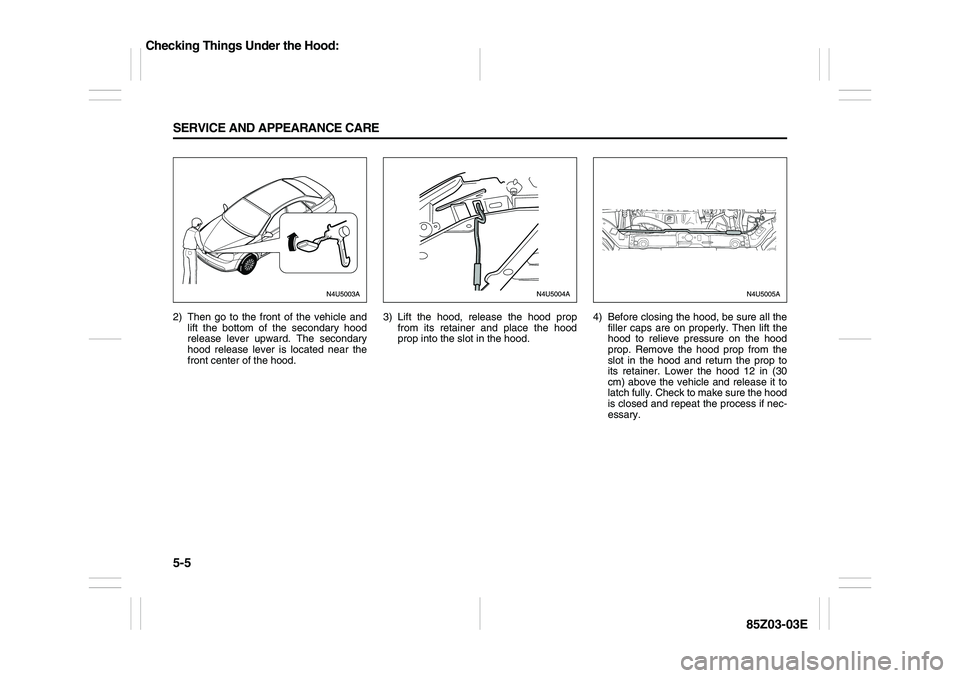
5-5 SERVICE AND APPEARANCE CARE
85Z03-03E
2) Then go to the front of the vehicle and
lift the bottom of the secondary hood
release lever upward. The secondary
hood release lever is located near the
front center of the hood.3) Lift the hood, release the hood prop
from its retainer and place the hood
prop into the slot in the hood.4) Before closing the hood, be sure all the
filler caps are on properly. Then lift the
hood to relieve pressure on the hood
prop. Remove the hood prop from the
slot in the hood and return the prop to
its retainer. Lower the hood 12 in (30
cm) above the vehicle and release it to
latch fully. Check to make sure the hood
is closed and repeat the process if nec-
essary.
Checking Things Under the Hood: